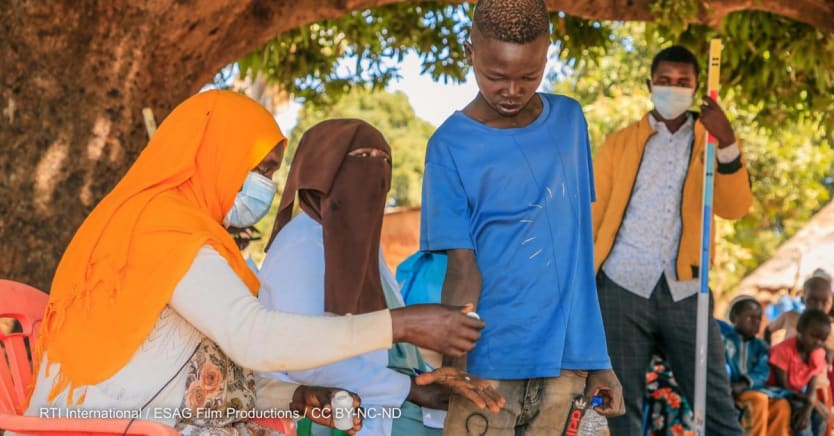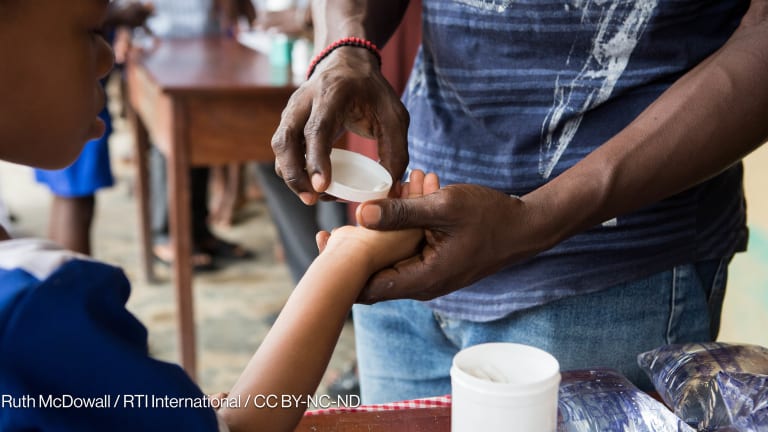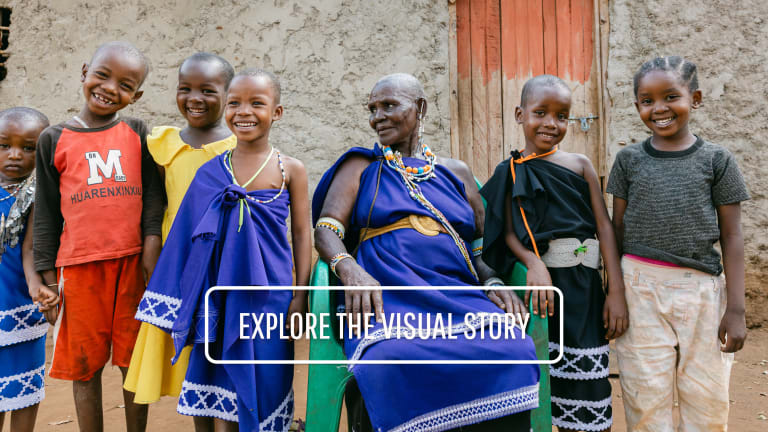
The death of former U.S. President Jimmy Carter at the end of 2024 brought an outpouring of gratitude for his work on neglected tropical diseases, or NTDs, particularly his efforts to eliminate dracunculiasis, or Guinea worm disease, in Angola, Chad, Ethiopia, Mali, and South Sudan. He was a powerful force in shining a light on this group of diverse conditions, which impact the world’s most overlooked and hard-to-reach communities.
Yet despite high-profile advocacy from President Carter and others, over 1 billion people worldwide — largely in tropical and subtropical areas — continue to be impacted by NTDs.
What are NTDs?
The World Health Organization defines neglected tropical diseases as a diverse group of conditions caused by various pathogens, including viruses, bacteria, parasites, fungi, and toxins. As of 2025, there are 21 officially recognized NTDs, including trachoma, schistosomiasis, noma, and dengue.
Alongside death and severe health problems — including blindness and disability — their economic toll is huge, trapping whole communities in poverty and limiting opportunities for education and employment.
“Progress is being made in a relatively large number of countries against different diseases. It shows what is possible.”
— Albis Francesco Gabrielli, team leader for strategic information and analytics on NTDs, WHOThese diseases predominantly impact some of the most marginalized and vulnerable populations. Limited infrastructure, remote geography, conflict, climate change, and migration can severely hinder public health efforts in these areas. By grouping these diseases together, WHO aims to raise its profile against better-funded illnesses such as malaria, tuberculosis, and HIV.
Albis Francesco Gabrielli, team leader for strategic information and analytics on NTDs at the World Health Organization said despite these incredible challenges, 54 countries have eliminated at least one NTD, with several countries having eliminated two or three, and Togo the first country to eliminate four.
“Progress is being made in a relatively large number of countries against different diseases. It shows what is possible,” he said.
The road to elimination
The first WHO road map on NTDs was published in 2012, but many of the targets originally set for 2020 were not met. The updated strategy for 2021-2030 noted that 600 million fewer people required interventions against several NTDs compared to 2010 — a 25% drop. But achieving the goal of 90% fewer people needing interventions means “radical change is needed for approaches to be integrated and mainstreamed into national health systems and for coordination of actions across sectors."
Despite the billions of doses of medicines that have been delivered, tackling these ancient diseases of poverty remains an uphill battle. The report aims to “renew momentum” while also making a strong economic case for investment.
Developed after extensive consultation, it identifies the specific gaps preventing progress for each of the diseases, Gabrielli explained. But it also signals a move away from external programs tackling single diseases. For action to be sustainable, the road map stresses that countries must have ownership. Multiple diseases should be addressed at the same time and sectors, such as health and agriculture, need to co-ordinate their efforts.
“Co-infection is very common with NTDs,” explained Gabrielli. “It is very difficult to find a person who only suffers from one. So when you are implementing activities, it is important not to limit yourself to one NTD, because with the same intervention or a small adjustment, you could easily target multiple diseases.”
“600 million fewer people required interventions against several NTDs compared to 2010 — a 25% drop.”
—WHO has consistently set ambitious targets for the elimination of NTDs to attract funding and support political advocacy, explained Mark Taylor, director of the Centre for Neglected Tropical Diseases at the Liverpool School of Tropical Medicine. But he also believes that “real world” challenges in delivering programs can lead to “reputational damage” from frequently shifting goalposts.
The updated road map now acknowledges what it will take, he said, and progress will be assessed every two years. Sustained efforts mean one of the diseases he works on — lymphatic filariasis — has now been eliminated from Malawi and Bangladesh, with Nepal and Ghana also close to elimination.
Taking a grassroots approach
Every year, 11 pharmaceutical companies donate more than 3 billion tablets to tackle NTDs. Yet delivering the medicine to where it is needed and getting effective coverage is an ongoing issue. Mass drug administration programs often target everyone in an area, but they also involve work within communities to tackle the stigma and improve understanding about why this is needed, said Taylor.
“You’re often trying to stop the spread of the disease, rather than curing the disease. To do that, you have to have high coverage and sustain it for many years.”
Making that shift from reliance on vertical donor programs to ownership by countries is needed, but will not be easy, he added: “They're called neglected tropical diseases for good reason — and they're always going to be bottom of the list of priorities in low- and middle-income countries’ strategic health planning.”
Particular impact has been seen with some diseases in specific regions, such as the Pacific islands and countries such as Thailand and Sri Lanka, which have “good functioning health systems”, Taylor said. However, scaling these issues to other countries will be challenging. “That is going to add another layer of complexity as we move forward,” he added.
Inspiring solutions
WHO acknowledges that research into novel vaccines, treatments, diagnostic tests, and vector control technology will be vital. A research and development blueprint is expected before the summer of 2025. Taylor gave the example of the discovery of a symbiotic bacteria that onchocerciasis and lymphatic filariasis depend on, which means a simple course of antibiotics could be curative.
Neglected tropical diseases officially recognized by WHO
Mycobacterium ulcerans infection (Buruli ulcer)
American trypanosomiasis (Chagas disease)
Dengue and chikungunya
Dracunculiasis (Guinea-worm disease)
Echinococcosis
Foodborne trematode infection
Human African trypanosomiasis (sleeping sickness)
Leishmaniasis
Leprosy
Lymphatic filariasis (Elephantiasis)
Mycetoma
Noma
Onchocerciasis (river blindness)
Rabies
Scabies
Schistosomiasis (snail fever)
Snakebite envenoming
Soil-transmitted helminth infections (hookworm, roundworm, whipworm)
Taeniasis/cysticercosis
Chlamydia trachomatis infection (trachoma)
Yaws
He added: “We also need new diagnostics, because we don't have the tools to know when to stop mass drug administration programs, which eat up enormous amounts of resources that should be used elsewhere.”
Michael Marks, professor of medicine at the London School of Hygiene and Tropical Medicine, explained that even within NTDs, some are more neglected than others, particularly where the solution is not a straightforward treatment you can give across a whole area.
“For yaws, I will bet you my entire salary between now and 2030 that target will not be met,” he said. Why? Because it’s not getting the high-profile attention it needs to generate motivation for eradication, Marks explained. An enormous eradication effort in the 1960s dramatically reduced the number of cases. It then fell off the agenda and has ticked along at a low but steady level ever since.
By contrast, human African trypanosomiasis, or sleeping sickness, is an “incredible success story,” he said, adding this has demonstrated how research can lead to more effective approaches. Management has evolved from injecting the patient with arsenic, which itself was fatal in 5%-10% of cases, to a single-dose tablet that anyone can take without the need for invasive tests.
“That has been driven by impressive people at Médecins Sans Frontières and incredibly dedicated teams, particularly in the Democratic Republic of Congo,” said Marks. “Whenever I propose a piece of research and someone says that it’s too hard to do, I tell them about that shift from incredibly horrendous drugs to a single dose tablet that children and pregnant women can have. I find that story the most inspiring.”
Visit Escape the Neglect — a series exploring the extraordinary progress that countries are making in eliminating neglected tropical diseases, or NTDs, and showcasing promising opportunities to build on recent wins.
This content is produced in partnership with our Escape the Neglect series. Click here to learn more.









